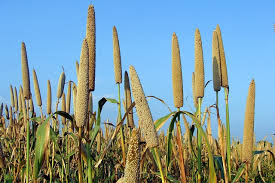
November 15, 2018, by Lexi Earl
Anatomics in Pearl Millet
We are excited to announce funding from The Royal Society 2018 International Collaboration Award scheme for the project entitled: ‘Anatomics in Pearl Millet: Improving yield and drought tolerance of a major dietary staple food in the Sahel’. This 3 year research project builds on the trans-disciplinary expertise of teams co-led by Prof Malcolm Bennett at the University of Nottingham, and Dr Ndjido Kane of the Senegalese Institute for Agricultural Research (Institut Sénégalais de Recherches Agricoles).
Pearl millet is a staple food for approximately 100 million people, and 90% is grown by smallholder farmers. Its grain is high in proteins, essential minerals, and energy. It is also gluten-free and contains hypoallergenic properties. It therefore has huge potential as part of a nutrient-rich diet, so it is crucial for researchers to better understand its properties. To facilitate this, an international consortium involving Dr Kane published the pearl millet genome sequence last year (Varshney et al. 2017). Later sequencing of a diverse collection of varieties revealed that pearl millet’s domestication occurred in West Africa (Burgarella et al. 2018).

Drought in the Sahel, a region bordering the southern edge of the Sahara in Africa, is a major hindrance to pearl millet production. As climate change brings unpredictable weather patterns and increasing temperatures, the need to select new varieties of pearl millet better adapted for future environmental scenarios is increasing.
As part of the international collaborative research award, the UK, Senegalese and French teams and their collaborators aim to identify varieties of pearl millet with improved root architecture and anatomical traits designed to improve resilience to drought stress. For example, selecting varieties with smaller water transporting vessels in roots would serve to conserve water reserves in the soil until later in the growing season when rain is limited and water is needed to mobilise nutrients into developing grains.

How will root imaging be done? Root samples will be collected during field trials in Senegal, then shipped back to a specialist facility at Nottingham. We will use a new high throughput anatomical imaging technique developed with US colleagues at Penn State (termed ‘anatomics’), where researchers use a high powered laser to cut and image many thousands of root sections in just minutes, then use advanced Deep Learning algorithms to automatically harvest data about key features such as cell number and size. The anatomics approach will enable researchers to rapidly screen varieties for desirable root anatomical traits from a diverse collection of pearl millet lines.
The ultimate goals of this project are to pinpoint the key genes that control desirable traits, share expertise, resources and data with research partners, breeders, and smallholder farmers, in order to advance breeding programmes, and develop more resilient crops. This will have real impact on the everyday lives of people living in the Sahel, and in other communities where pearl millet is grown as a staple crop.
The international collaborative research award is in addition to a new GCRF funded networking grant to both teams entitled “Enhancing pearl millet productivity and marketability in sub-saharan Africa” that aims to develop sustainable partnerships, research exchanges, and capacity strengthening on pearl millet research with collaborators in Rothamsted and Institut de Recherche pour le Développement (France). It will support long term research exchanges and capacity strengthening between Senegal and UK expertise in nutrition, grain quality and brewing research areas to deliver added value to pearl millet.
References:
Burgarella, C., Cubry, P., Kane, N.A. et al. (2018) A western Sahara centre of domestication inferred from pearl millet genomes. Nature Ecology and Evolution 2, pp.1377-1380
Varshney, R.K., Shi, C., Thudi, M. et al. (2017) Pearl millet genome sequence provides a resource to improve agronomic traits in arid environments. Nature Biotechnology 35, pp. 969-976
Previous Post
The Food Innovation Centre at UoNNext Post
Future Proteins: Is it all crickets?No comments yet, fill out a comment to be the first

Leave a Reply